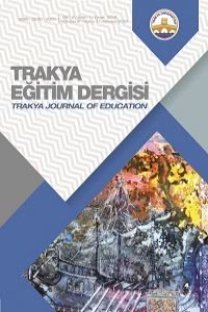Vaka Çalışması: Okuma Güçlüğü Çeken Okurların Interaktif Dijital Kitap ile OkumaYazma Tecrübeleri
A Case Study: Literacy Experiences of Struggling Readers with Interactive Digital Books
___
- Allington, R. L. (2007). Intervention all day long: New hope for struggling readers. Voices from the Middle, 14(4), 7-14.
- Anderson-Inman, L., & Horney, M. A. (2007). Supported e-texts: Assistive technology through text transformations. Reading Research Quarterly, 42(1), 153-160.
- Boone, R., & Higgins, K. (2007). The role of instructional design in assistive technology research and development. Reading Research Quarterly, 42(1), 134-153.
- Cheung, A., & Slavin, R. E. (2013). Effects of educational technology applications on reading outcomes for struggling readers: A best-evidence synthesis. Reading Research Quarterly, 48(3), 277- 2999.
- Chiong, C., Ree, J., Takeuchi, L., & Erickson, I. (2012). Print books vs. e-books. Retrieved from http://www.joanganzcooneycenter.org/wpcontent/uploads/2012/07/jgcc_ebooks_quickreport.pdf
- Cooper, A. (2004). The inmates are running the asylum: Why high-tech products drive us crazy and how to restore the sanity. Indianapolis, IN: Sams.
- Creswell, J. W. (2003). Research design: Qualitative, quantitative, and mixed methods approaches. Thousand Oaks, CA: Sage.
- Creswell, J. W. (2007). Qualitative inquiry and research design: Choosing among five traditions. Thousand Oaks, CA: Sage.
- Dalton, B. (2014). DIY e-books: Designing enhanced texts. The Reading Teacher, 67(7), 543-546.
- Demiroz, E., & Demiroz, E. (2018). Enactive nature of scholarship and e2TPR. In Wang, V. C. (Ed.), Handbook of Research on Positive Scholarship for Global K-20 Education (pp. 201-216). IGI Global.
- Falth, L., Gustafson, S., Tjus, T., Heimann, M., & Svensson, I. (2013). Computer‐assisted interventions targeting reading skills of children with reading disabilities: A longitudinal study. Dyslexia, 19(1), 37-53.
- Gibson Jr, L., Cartledge, G., & Keyes, S. E. (2011). A preliminary investigation of supplemental computer-assisted reading instruction on the oral reading fluency and comprehension of firstgrade African American urban students. Journal of Behavioral Education, 20(4), 260-282.
- Guthrie, J. T., & Davis, M. H. (2003). Motivating struggling readers in middle school through an engagement model of classroom practice. Reading &Writing Quarterly, 19(1), 59-85.
- Henderson, A. T., & Berla, N. (1994). A new generation of evidence: The family is critical to student achievement. Washington, DC: Center for Law and Education.
- Kena, G., Aud, S., Johnson, F., Wang, X., Zhang, J., Rathbun, A., Wilkinson-Flicker, S., & Kristapovich, P. (2014). The condition of education 2014 (NCES 2014-083). Washington, DC: U.S. Department of Education, National Center for Education Statistics. Retrieved September 21, 2015 from http://nces.ed.gov/pubsearch
- Laverick, D. (2014). Supporting striving readers through technology-based instruction. Reading Improvement, 51(1), 11-19.
- McClanahan, B., Williams, K., Kennedy, E., & Tate, S. (2012). A breakthrough for Josh: How to use of an iPad facilitated reading improvement. TechTrends, 56(3), 20-28.
- Missouri Department of Elementary and Secondary Education. (2014). District and school information. Retrieved from http://mcds.dese.mo.gov/Pages/District-and- School-Information.aspx
- Selfe, C. L. (1999). Technology and literacy: A story about the perils of not paying attention. College composition and communication, 50(3), 411-436.
- Slavin, R. E., Lake, C., Davis, S., & Madden, N. A. (2011). Effective programs for struggling readers: A best-evidence synthesis. Educational Research Review, 6, 1, 1-26.
- Udo, G. J. (2001). Privacy and security concerns as major barriers for e-commerce: A survey study. Information Management & Computer Security, 9(4), 165-174.
- Wasik, B. A., & Slavin, R. E. (1993). Preventing early reading failure with one-to-one tutoring: A review of five programs. Reading Research Quarterly, 28(2), 178- 200.
- Zucker, T. A., Moody, A. K., & McKenna, M. C. (2009). The effects of electronic bookson prekindergarten-to-grade 5 students' literacy and language outcomes: A research synthesis. Journal of Educational Computing Research, 40(1), 47-87.
- ISSN: 2630-6301
- Yayın Aralığı: 3
- Başlangıç: 2011
- Yayıncı: Trakya Üniversitesi Eğitim Fakültesi
Dolaylı veya Doğrudan Düzeltme Geribildirimi: Bir Eylem Araştırması
Sınıf Öğretmenlerinin Özel Gereksinimli Öğrencilerin Eğitimine Yönelik Görüşlerinin İncelenmesi
Çocuklara İngilizce Öğretiminde Kart Sihirbazlıklarının Kullanımı
Türkçe Dersi Öğretim Programlarının Karşılaştırmalı Analizi (2009-2017-2019)
Nurdan KALAYCI, Nilay YILDIRIM
Zekiye Hande YILMAZ, Asude MALKOÇ
